Lead Qualification Questions: How to Identify Quality Prospects
Updated on September 30, 2025Every minute spent chasing the wrong prospect is a minute lost in closing a deal that matters. The challenge isn’t just about refining your sales pitch or mastering objection handling. It’s about asking the right questions at the right time to qualify your leads effectively.
Top-performing sales teams don’t just hustle harder. They qualify smarter. They know that a well-timed, strategic question can unlock a prospect’s true needs and buying potential.
Mastering the art of qualification conversations is what separates the high achievers from the rest. Let's see how to manage this process together.
Understanding Lead Qualification Fundamentals
Imagine your sales team spending hours nurturing a prospect. Sending personalized emails, scheduling calls, and demonstrating your product. Only to find out at the last moment that the prospect lacked the budget, authority, or real need for your solution.
This common scenario wastes resources and hurts team morale.
What Is Lead Qualification and Why It Matters
Basically, lead qualification involves asking the right questions at the right time. These questions helps you to determine if a prospect is likely to become a customer.
It acts as a filter that helps you focus on serious buyers, saving time and effort. By evaluating prospects against specific criteria, you can assess their potential to convert.
The real value of qualification lies in matching your offering to the prospect’s needs. A well-qualified lead usually:
- Has a problem your product solves
- Is dissatisfied with their current situation
- Has the budget to invest
- Holds the authority to make purchasing decisions
When teams skip qualification, they waste time on prospects unlikely to convert. Effective qualification streamlines your process and improves the experience for everyone. Prospects appreciate when you quickly understand their needs and honestly assess whether there’s a fit.
The Cost of Unqualified Leads
Unqualified leads carry hidden costs that accumulate over time. For example, while your top salesperson focuses on a lead without budget approval, you might miss other qualified prospects. This leads to longer sales cycles, inaccurate forecasts, and lower morale when deals fall through late.
These problems affect your entire organization:
- Marketing struggles to identify which campaigns bring quality leads
- Customer success teams handle clients who were never a good match, causing low product adoption and churn
- Product teams receive misleading feedback when sales chases prospects whose needs don’t align with your core offering
If missed forecasts and long sales cycles resonate, get a concise primer on B2B lead qualification with practical questions and examples you can plug into your next discovery call.
Popular Lead Qualification Frameworks
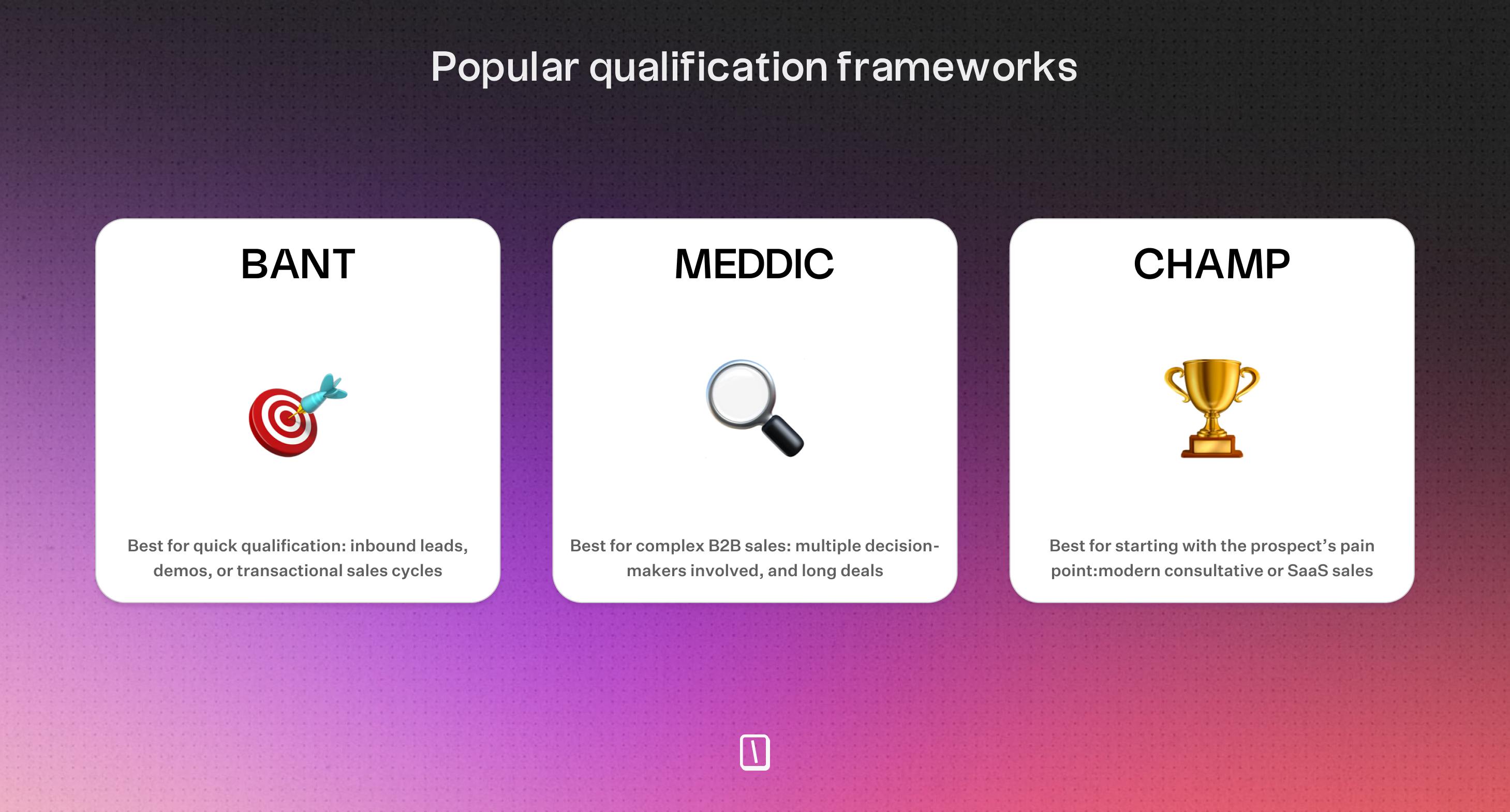
Qualification frameworks bring structure and consistency to sales conversations. Instead of relying on instinct, sales teams use these systems to determine which leads are worth pursuing.
1. BANT: Budget, Authority, Need, Timing
Developed by IBM, BANT is a foundational framework. It works best for quick qualification. Especially for inbound leads, demos, or transactional sales cycles.
| Component | Purpose | Example Prompt |
|---|---|---|
| Budget | Can they afford the solution? | "Do you already have budget allocated for this?" |
| Authority | Are you speaking to a decision-maker? | "Who else is involved in making the final decision?" |
| Need | Is there a clear pain or business challenge? | "What issues are you trying to solve right now?" |
| Timing | When are they planning to buy? | "When would you like to implement a solution like this?" |
Use case:A SaaS company offering $99/month CRM software may use BANT to filter demo requests. Leads without clear needs or budget aren’t passed to sales reps.
Why it’s useful:
-
Simple and fast to apply
-
Helps SDRs avoid wasting time
-
Great for high-volume lead generation
Limitation:
- Not ideal for longer, multi-stakeholder sales processes
2. MEDDIC: Metrics, Economic Buyer, Decision Criteria, Decision Process, Identify Pain, Champion
MEDDIC is often used in complex B2B sales. Especially when multiple decision-makers are involved, and deals take months to close.
| Component | Purpose | Example Prompt |
|---|---|---|
| Metrics | What measurable value can the product deliver? | "How do you currently measure ROI in this area?" |
| Economic Buyer | Who owns the budget and final decision? | "Who signs off on new vendor contracts?" |
| Decision Criteria | What matters most when selecting a solution? | "What’s most important to you—price, ease of use, support?" |
| Decision Process | What steps will be taken to make a final decision? | "What’s the typical approval flow for purchases like this?" |
| Identify Pain | What critical problem are they trying to solve? | "What is holding your team back from hitting targets?" |
Use case:An enterprise cybersecurity company might use MEDDIC to navigate a six-month sales cycle. They can align with IT and legal teams while building a relationship with an internal champion.
Why it’s useful:
-
Deep insight into the buying process
-
Helps reps align their sales pitch to customer priorities
-
Encourages strong internal advocacy
Limitation:
- Requires skilled reps and longer discovery phases
3. CHAMP: Challenges, Authority, Money, Prioritization
CHAMP flips the script by starting with the prospect’s pain point. It’s well suited for modern consultative or SaaS sales, where value and trust matter more than hard selling.
| Component | Purpose | Example Prompt |
|---|---|---|
| Challenges | What are their business problems? | "What’s the biggest blocker to your current growth?" |
| Authority | Are you speaking with someone who can make decisions? | "Who else should we involve in this conversation?" |
| Money | Do they have a budget, or can one be created? | "How does your team typically fund new tools or vendors?" |
| Prioritization | Is solving this problem urgent or a nice-to-have? | "Where does this rank among your Q3 initiatives?" |
Use case:A customer experience platform might use CHAMP to lead discovery with mid-sized businesses. Starting with challenges like “retaining churn-risk customers” and gradually shifting toward budget and buying readiness.
Why it’s useful:
-
Puts the prospect’s problems at the center
-
Helps build credibility early in the conversation
-
Encourages meaningful, trust-based discovery
Limitation:
- May delay pricing conversations, which can be risky in late-stage sales
Choosing the Right Framework
| Framework | Best For | Strengths | Limitations |
|---|---|---|---|
| BANT | Inbound leads, short sales cycles | Quick, scalable, easy to teach | Lacks depth for complex sales |
| MEDDIC | Enterprise sales, multiple stakeholders | Detailed, strategic, aligned with big deals | Takes time and trained sales teams |
| CHAMP | Consultative or SaaS sales | Problem-first, builds early trust | Less clarity around budget early on |
When to Qualify Leads in Your Sales Process
Timing matters in qualification. Asking about budget too early can seem pushy; waiting too long wastes time. The most effective strategy is to integrate qualification throughout your sales process, adjusting questions for each stage.
- Initial qualification: During first contact, check for basic fit. Does the prospect match your ideal customer profile? Do they have a problem you can solve? Keep questions conversational and relevant.
- Deeper qualification: Use discovery calls to explore the prospect’s buying process, success criteria, and obstacles. Frameworks like MEDDIC help you understand if you can deliver value, not just tick boxes. Watch for red flags like misaligned expectations or competing priorities.
- Ongoing qualification: Markets shift, budgets change, and new stakeholders appear. What seemed like a great opportunity last month might not be viable today. Regular check-ins keep both sides aligned and committed.
Qualification is a continuous process that ensures your sales efforts focus on the right opportunities.

Eliminate the need for developers—build your bot in minutes.
No trial. Generous free plan.
Budget and Authority Qualification Questions
Money always influences sales, but discussing budget and decision-making authority requires care. Balancing these conversations is crucial. Push too hard, and you risk losing promising leads. Move too slowly, and you waste time on prospects who can't buy.
Essential budget qualification questions to ask
Effective budget qualification involves uncovering financial realities through thoughtful questions. Not bluntly asking, “What’s your budget?” Experienced sales professionals build context and trust gradually.
Start with questions that lead naturally to budget discussions, such as:
- “What are you currently spending to solve this issue?” This establishes a baseline and acknowledges the posibble investment.
Explore the cost of inaction:
- “What happens if you do nothing about the problem?” This shifts focus from price to value. When prospects describe the consequences of inaction, they often reveal how flexible their budget is.
Ask about budget allocation:
- “Can you provide an overview of your current budget allocation for new purchases?” This reveals available funds and priorities. Even if money exists, it may be reserved for other initiatives, making timing important.
If the prospect uses a competitor’s solution, try benchmarking:
- “How does your current investment compare to your expected results?” This positions you as a consultant.
Questions to Identify Decision-Makers and Buying Authority
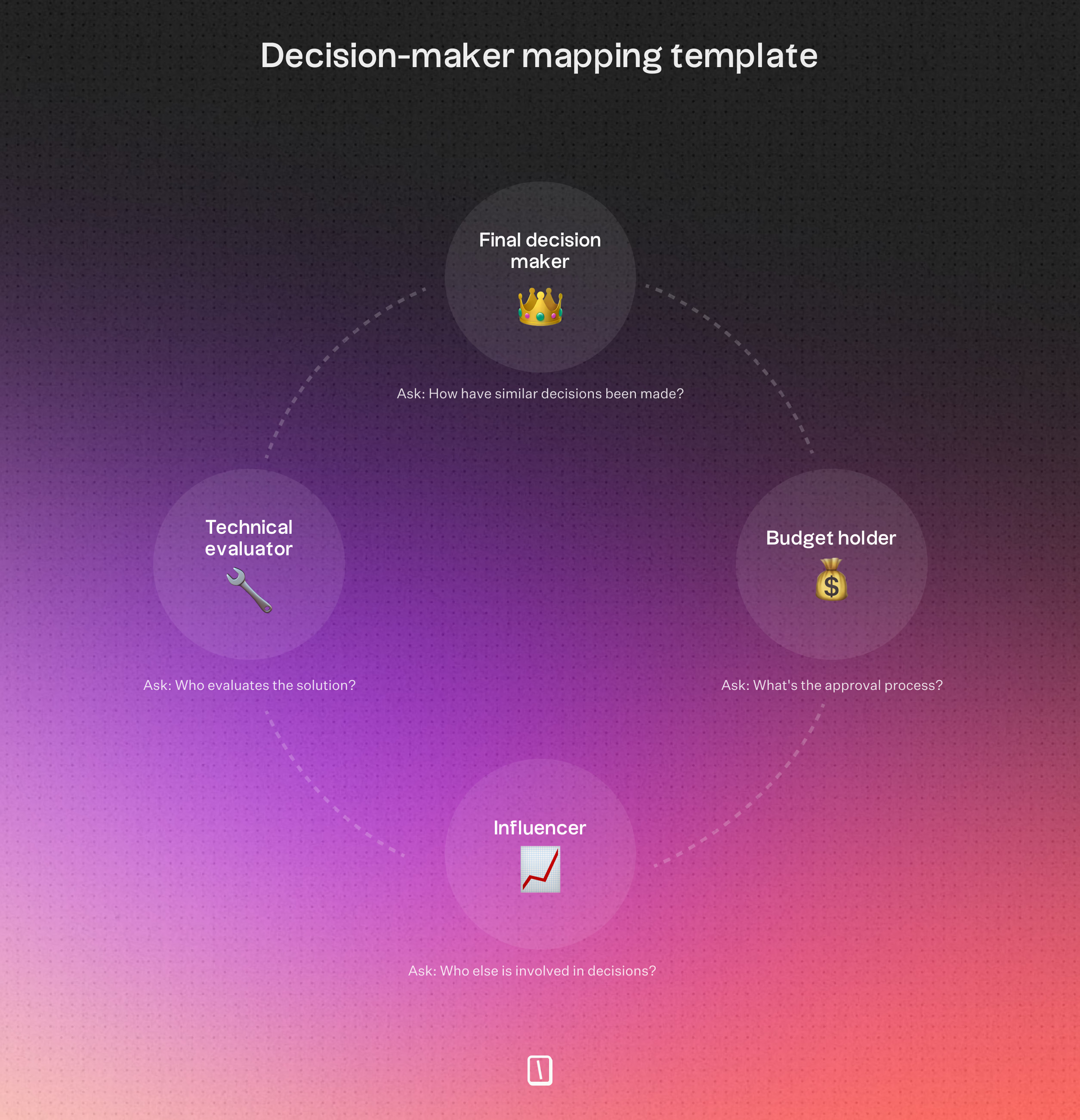
Finding who holds buying authority requires investigation, not interrogation. The person you speak with may not decide but often influences the process. Use nuanced questions to understand the dynamics.
Start gently:
- “Who is usually involved in buying decisions for new tech?” This encourages prospects to share without pressure.
Dig deeper:
- “How does the purchase approval process work?” This shows you understand complex sales and helps you learn about approval steps.
Clarify roles as the deal progresses:
- “What would be your role in the process, and the roles of others on the decision team?” This respects your contact’s importance. You might find your contact is the technical evaluator, the CFO controls the budget, and the department head makes the final call.
Look at past decisions:
- “How have similar purchasing decisions been made in your organization?” Understanding history helps building your strategy.
How to Handle Budget Objections Tactfully
When prospects raise budget objections, they rarely mean “we have no money.” Usually, they don’t see enough value. Recognizing this lets you respond better.
Reframing works well. Pete Caputa’s approach, from HubSpot, goes like this:
- “We’ve established your goal is X and you’re spending Y now to achieve it. But it’s not working. To hire us, you need to invest Z. Since Z is similar to Y and you’re more confident our solution will get you to your goal, does it make sense to invest Z to hire us?”
This validates current spending, highlights the gap between investment and results. Plus, it positions your solution as a smarter use of resources.
If a prospect says, “we don’t have budget,” try a timing pivot:
- “When do you expect to have one?” This keeps the conversation open and reveals their fiscal cycles and funding processes.
Position yourself as a partner:
- “What would need to happen for you to secure budget for this initiative?” This shows you care about their success. Like ROI projections or case studies to build a business case internally.
Red Flags That Indicate Budget Misalignment
Experienced sales professionals spot budget misalignment, but anyone can watch for these signs:
-
A huge gap between your price and the prospect’s budget. For example, if your product costs $1 million and their budget is $100, no negotiation will close that gap.
-
Vague or evasive answers to budget questions. Serious buyers usually know investment levels, even without final approval. Deflections or statements like “money is no object” may show lack of seriousness or authority.
-
Comparing your solution to free or consumer-grade tools. This may mean the prospect doesn’t understand your value or isn’t in your target market.
-
Hesitation to commit staff time for onboarding. This suggests they may not be ready for your solution, regardless of budget.
-
Unclear funding sources. Purchases from operational budgets face different constraints than capital expenditures. If a prospect says they need to “find money in the budget,” ask if they mean reallocating funds, requesting new funding, or hoping for a surplus.
-
Historical spending patterns. If a company never spent more than $10,000 on software but now considers $100,000, internal hurdles may be cultural, not financial. Recognizing this early helps set realistic expectations and strategies.
Before you start building your qualification flow, review our comprehensive lead qualification checklist to ensure you're covering all the critical red flags and green flags that separate serious buyers from tire-kickers.

Enhance your chatbot's capabilities with advanced AI from OpenAI and Anthropic.
No trial. Generous free plan.
Step-by-Step: Qualifying Leads with Typebot Using the AI Block
Typebot is a no‑code, AI-powered chatbot builder that helps you qualify leads, capture data, and route it to your CRM in minutes. With a drag‑and‑drop flow builder and an AI block, you can ask smarter questions, score responses, and automate follow‑ups, without engineering.
Compare platforms in this guide to lead qualification tools.
1. Start Your Flow
- Create a Typebot.
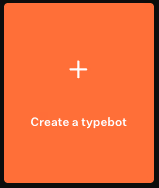
- Select create from scratch.
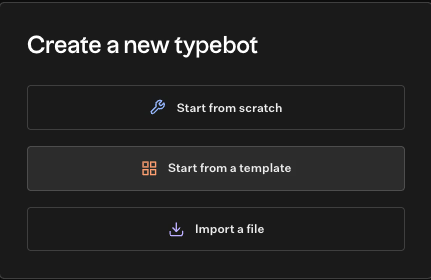
2. Add a Welcome Message
-
Drag a Text block onto the canvas and connect it to the Start node.
-
Enter a friendly greeting, such as: “Welcome! I’ll ask a few quick questions to see if we’re a great fit for your needs.”
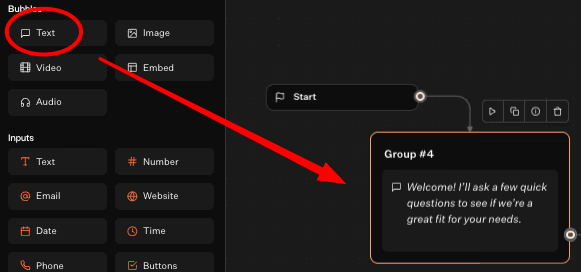
3. Ask for the Lead’s Name
-
Drag a text block.
-
Set the placeholder to: “Type your name…”
-
Save the answer in a variable. Like "
lead_name". -
Connect it to the first block.
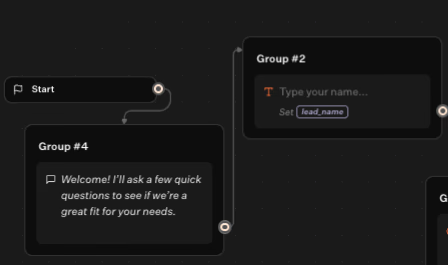
4. Ask for the Lead’s Email
-
Drag an Email input block onto the canvas and connect it after the name input.
-
Set the placeholder to: “Type your email…”
-
Save the answer in a variable (e.g.,
lead_email). -
Do not forget to connect the blocks.
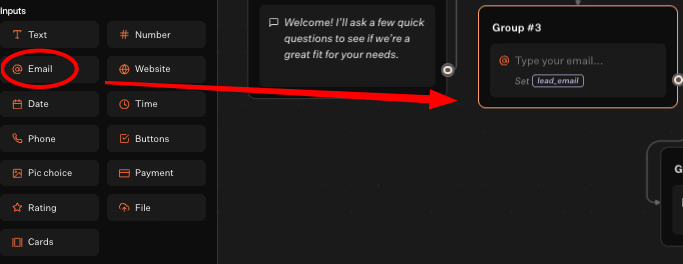
5. Ask for Company Size
- Drag a Text block first.** After that, add buttons beneath.
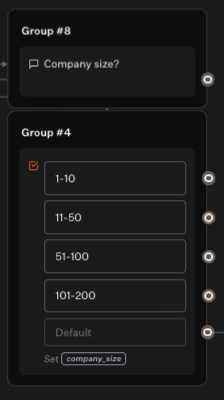
-
Add options such as:
-
“1-10”
-
“11-50”
-
“51-100”
-
“101-200”
-
-
Save the answer in a variable (e.g.,
company_size).
6. Ask About Project Needs
-
Drag another Text input block onto the canvas and connect it after the company size input.
-
Set the placeholder to: “Briefly describe your project goals or needs…”
-
Save the answer in a variable (e.g.,
project_needs).
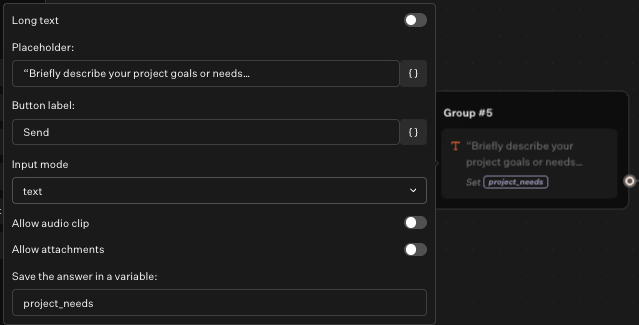
7. Qualify the Lead Using the AI Block
- From the Integrations section, drag the OpenAI block onto the canvas and connect it after the last input.
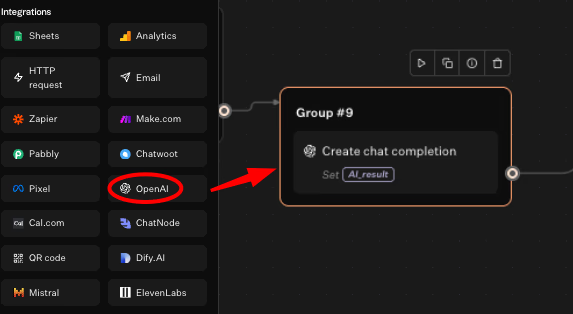
- Select your OpenAI account.
- Select Create Chat Completion.
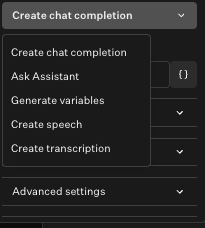
- Select the model.
In the prompt field, craft a message such as:
Based on the following information, determine if this lead is qualified for our consulting services. Name: {{name}} Email: {{lead_email}} Company size: {{company_size}} Project needs: {{project_needs}} Respond with "Qualified" or "Not Qualified" and a brief reason.
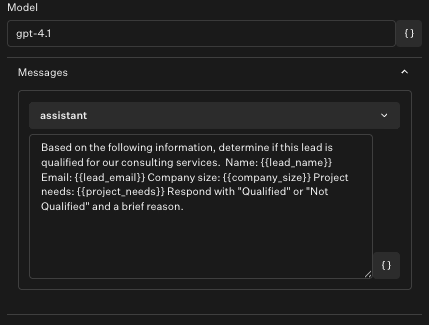
- Save the response as
AI_result
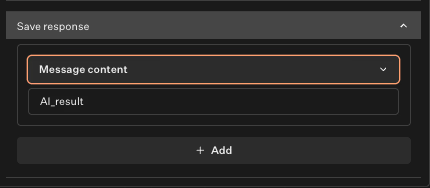
8. Store or Forward Lead Data
-
Use the Sheets integration. It will automatically save the lead’s information and the AI’s qualification result for your team’s follow-up.
-
Drag a Sheet block.
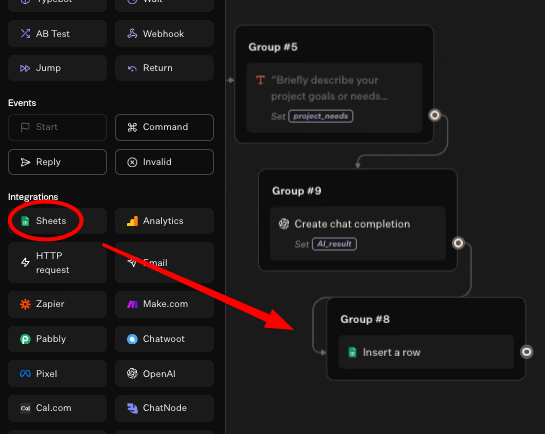
- Select your account and Sheet. Pick Insert a row. Add values for each column.
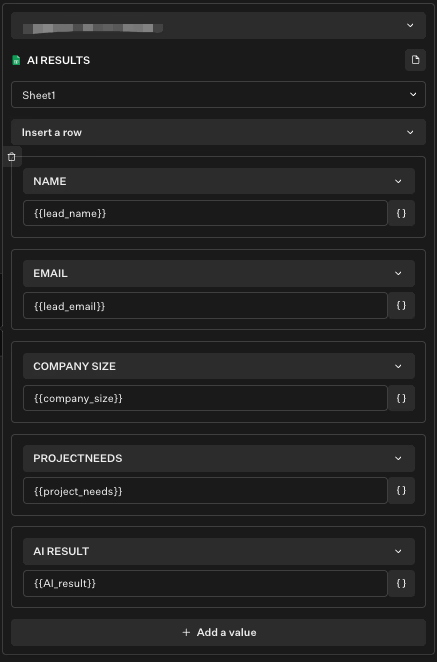
- Do not forget to create every row in your Sheet. Otherwise the integration won't work.
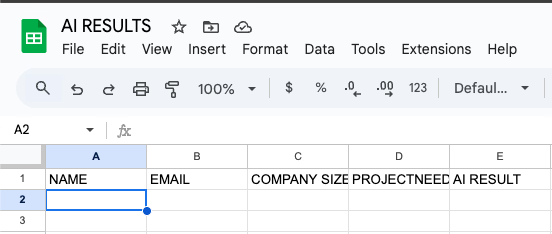

- All set! The results will appear in your sheet.
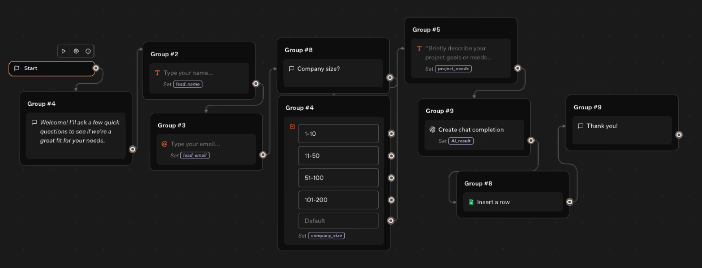
Summary Table
| Step | Block Type | Key Settings/Inputs |
|---|---|---|
| Welcome | Text | Friendly intro message |
| Name | Text Input | Placeholder: “Type your name…” |
| Email Input | Placeholder: “Type your email…”; Retry; Save as variable | |
| Company Size | Buttons | Options for employee ranges; Save as variable |
| Project Needs | Text Input | Placeholder: “Describe your project goals…” |
| AI Qualification | OpenAI | Prompt with all variables for qualification |
| Show Result | Text | Display AI’s output |
| Store Data | Sheets/Email | Save all collected info and AI result |
AI-powered lead qualification flow in Typebot that collects all essential information and instantly assesses each lead. Saving your team time and ensuring consistent, data-driven qualification.
As you refine your Typebot qualification flow, brush up on chatbot best practices to optimize question sequencing, tone, and UX for higher completion rates. These tips help reduce drop-offs and make your automated qualification feel more natural.
Transform Your Sales Process with Strategic Lead Qualification Questions
The right lead qualification questions can transform scattered sales efforts into a focused, high-converting pipeline. This pipiline consistently delivers quality prospects.
Carefully adapt these frameworks, questions, and automation strategies. You'll spend less time chasing unqualified leads and more time closing deals that matter.
Start with a few key questions from each category. Build your qualification process gradually, and watch your conversion rates climb as you attract prospects.

Replace outdated forms with engaging, interactive chatbots.
No trial. Generous free plan.